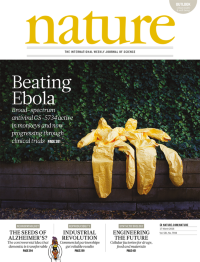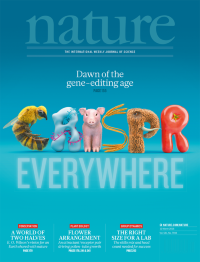Volume 531
-
No. 7596 31 March 2016
A Landsat 8 natural-colour mosaic of the ice cliff at the terminus of Thwaites Glacier, West Antarctica on 9 January 2016. Robert DeConto and David Pollard use a newly improved numerical ice-sheet model calibrated to Pliocene and last interglacial sea-level estimates to develop projections of Antarcticas evolution over the next five centuries, driven by a range of greenhouse gas scenarios. The modelling shows that the Antarctic ice sheet has the potential to contribute between almost nothing, to contributing more than a metre of sea-level rise by 2100 and more than 15 metres by 2500. The startling high-end estimate arises from unabated emissions and previously underappreciated mechanisms: ice-fracturing by surface meltwater and collapse of large ice cliffs. The low end shows that a scenario of strong climate mitigation can radically reduce societal exposure to higher sea levels. Cover: Knut Christianson, using data available from the US Geological Survey.
-
No. 7595 24 March 2016
This issue features a special on the circular economy�, a term coined by Swiss architect-engineer Walter Stahel, who has been a leader in developing the concept of sustainability as applied to industrialized economies. In a Comment piece, Stahel outlines the key principles of a waste-free� world: reuse, repair, remanufacture and upgrading. The ultimate goal, he writes, is to recycle atoms. John Mathews and Hao Tan track Chinas progress towards a circular economy, a process that needs to be tracked using more sophisticated metrics, they suggest. In a third Comment, developmental psychologist Bruce Hood asks why we hoard possessions to enhance our social status and highlights the need to make recycled goods more socially desirable. Finally, Books & Arts focuses on how eco-design can make circular economy principles work. Cover art: Viktor Koen
-
No. 7594 17 March 2016
Protective suits left to dry after an Ebola training session held by the Spanish Red Cross in Madrid in October 2014. A new study in this issue reports the discovery of a small-molecule drug, GS-5734, which has antiviral activity against Ebola and other filoviruses, and is capable of providing post-exposure protection against Ebola virus in 100% of infected macaques tested. Now in clinical trials (http://go.nature.com/PEW2Oi), the drug targets the viral RNA-dependent RNA polymerase and is readily scalable for future outbreaks. GS-5734 is able to distribute to sanctuary sites for viral replication including the testes, eye and brain, offering the hope that this drug may also be able to clear recrudescent and persistent virus infection. Cover photo: Susana Vera/Reuters
-
No. 7593 10 March 2016
The development of the CRISPRCas9 gene-editing tool has revolutionized molecular biology. Used to modify the genomes of viruses, bacteria, animals and plants, it has the potential to reveal the secrets of genomic organization, combat disease, improve crops, make designer pets and much more. All this � complicated by the announcement that the technique has been used to modify the genomes of human embryos � presents formidable ethical problems for regulatory bodies to wrestle with. This special issue of Nature surveys the CRISPRCas9 scene and poses the question: what do we want a gene-edited world to look like? Cover art by Chris Labrooy.
-
No. 7592 3 March 2016
The eukaryote cell is so much larger and more complex than the cells of bacteria and archaea that it is hard to recreate the steps whereby it evolved. One current view is that the evolution of eukaryotes was triggered when an archaea-like cell accommodated the bacteria that went on to become mitochondria. An alternative view is that eukaryotes were well on the way to their modern form before they acquired the bacteria that became mitochondria. This second view is supported by a study by Alexandros Pittis and Toni Gabald showing that mitochondrial genes are more closely similar to those of their supposed bacterial relations than many other eukaryote genes are to their own inferred prokaryote cousins. This result, which challenges current views, suggests that mitochondria were late additions to a eukaryote cell that was already evolving. Cover: Iris Joval & Toni Gabald





